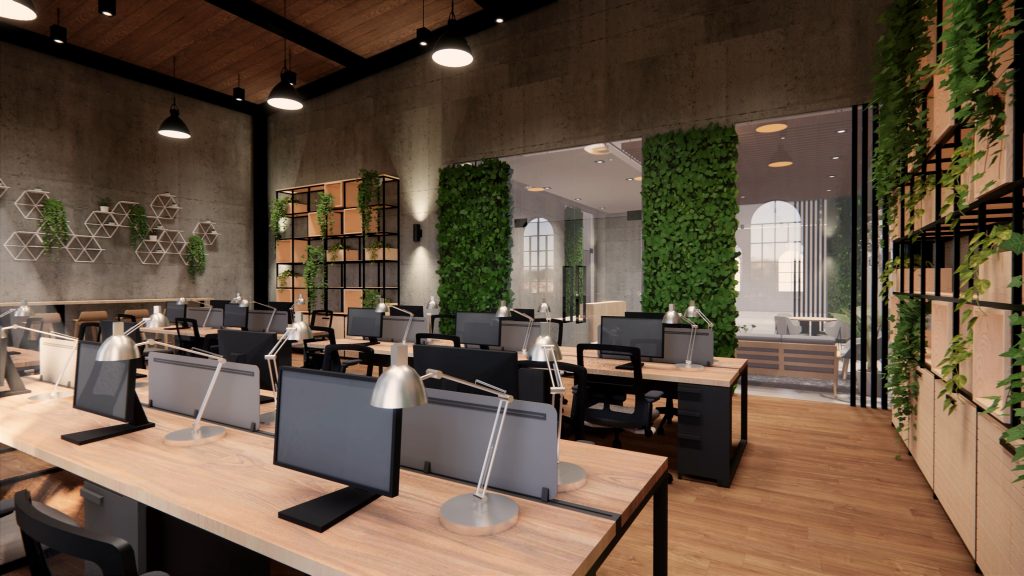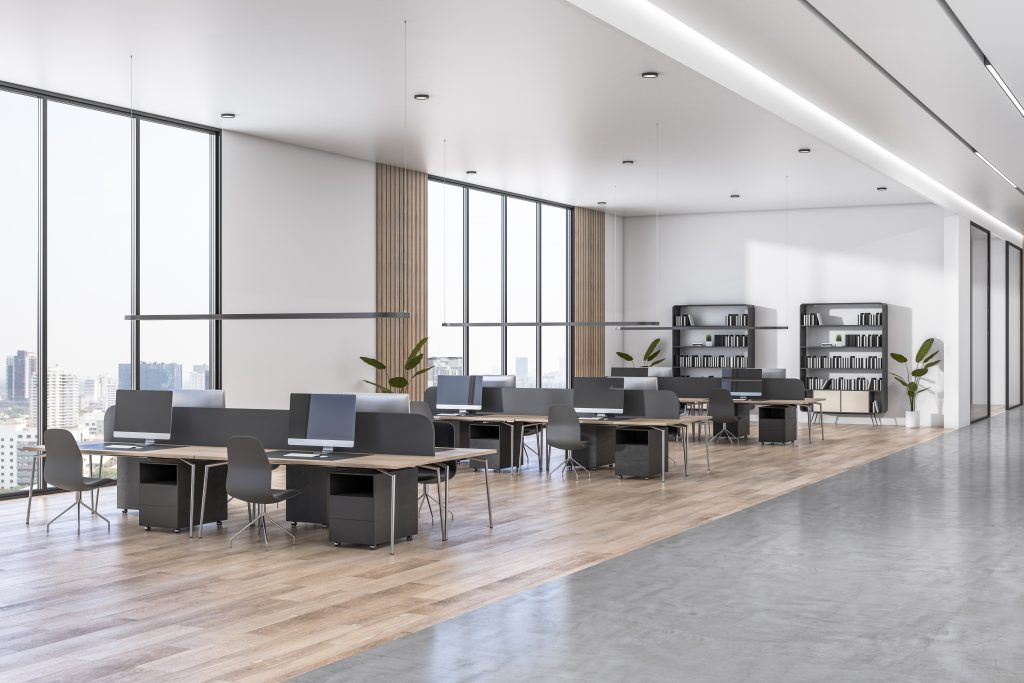The widespread use of technology in the workplace is greatly influenced by the latest developments in office furniture fit-out. Here are a few factors emphasizing the value of office furniture fit-out trends for embracing technology:
Flexibility and Adaptability: As technology advances quickly, workspaces need to have flexible arrangement features. Businesses can readily operate new technology and equipment by implementing contemporary office fitout furniture designs like modular workstations, adjustable desks, and movable walls. This adaptability enables the effective integration and reorganization of technology inside the workspace as requirements change over time.
Enhanced Connectivity: Contemporary office furniture styles frequently incorporate tech-friendly elements like built-in power outlets, USB connections, cable management systems, and wireless charging options. With the help of these characteristics, employees can quickly connect to power outlets, gain access to data connections, and use their devices, computers, smartphones, and other technological equipment without any restrictions.
Ergonomics and well-being: As technology became integrated into regular work processes, the amount of time people spend in front of screens and devices has increased. The latest office design ideas put a strong emphasis on ergonomic solutions that value the comfort and well-being of employees. The danger of work-related injuries is reduced because of ergonomic workstations, monitor stands, and chairs that may be adjusted to the user’s height. A better work environment and overall productivity are promoted by using ergonomically designed furniture.
Aesthetics and Modernity: Adopting technology in the workplace involves more than just making it functional; it also entails creating an atmosphere that represents a cutting-edge and creative culture. By using sleek designs, clean lines, and innovative materials, office furniture fitout trends adhere to modern aesthetics. Businesses can design a visually appealing workstation that fits their corporate image and aids in attracting and retaining the finest employees by incorporating technology-friendly furniture with a modern touch.
Collaboration and communication: The use of technology has changed how individuals interact and communicate at work. Open-plan designs, collaborative workstations, and interactive meeting areas are among the many office furniture design trends that foster teamwork and utilize technology-enabled collaboration tools. By incorporating technology-friendly furniture, you can boost productivity and innovation by facilitating effective communication, webinars, and the exchange of digital content.

The Role of Technology in Modern Office Furniture Fit Outs
- Smart Desks and Ergonomic Innovations
Smart desks use technology to increase connectivity, comfort, and productivity in the office. These workstations frequently have integrated controls or user interfaces that let users customize the height, tilt, and other ergonomic settings to suit their tastes. Some smart desks also feature built-in USB connections, wireless charging pads, and power outlets, allowing users to charge their gadgets effortlessly. Furthermore, more sophisticated smart desks could have sensors or connectivity choices to connect to other gadgets or office systems, such as lighting, climate control, or scheduling software.
Innovations in ergonomic design have been greatly enhanced by technology, which has also led to substantial improvements in workplace furniture fit-out. By lowering the risk of musculoskeletal problems and increasing comfort, ergonomic furniture seeks to maximize the health and productivity of workers. Innovative ergonomic designs influenced by technology include:
a. Adjustable Chairs: Ergonomic chairs with innovative mechanisms and sensors enable users to change seat height, backrest angle, lumbar support, and armrest placements. To give individualized support based on the user’s body form and weight distribution, some chairs also use pressure-sensitive materials.
b. Posture monitors: These tools track and give feedback on a user’s Posture using wearable electronics or sensors. They can warn users when they adopt bad sitting postures or hold one Posture for an extended period of time, motivating them to maintain better ergonomics.
c. Sit-Stand Workstations: Users can alternate between sitting and standing at height-adjustable desks during the working day. Some versions might even have predetermined height settings or signals to remind users to get up and walk about more frequently, which could lower the hazards to their health from extended sitting.
d. Monitor Arms and Mounts: Users can place their screens at eye level using adjustable monitor arms or mounts, which relieves neck and eye strain. These options allow for flexible screen positioning and support multiple displays for multitasking.
e. Ergonomic Keyboards and Mouse: Ergonomic mouse and keyboard designs have characteristics that support natural hand and wrist positions, lowering the risk of repetitive strain injuries. Several models feature split or curved designs, adjustable angles, and palm rests to increase comfort while using a mouse or keyboard.
Using technology in office furniture setups improves connectivity, productivity, and employee well-being. Businesses can boost employee satisfaction and overall success by implementing ergonomic advancements like smart desks and ergonomic workstations.

• Collaborative Spaces and Agile Furniture
Within the professional setting, collaborative spaces can be created through the use of technology. These areas are created to encourage teamwork, communication, and knowledge exchange. Here are some ways that technology helps collaborative spaces:
a. Interactive displays: Large dynamic displays, like touchscreen monitors or digital whiteboards, can be installed in collaboration spaces. These screens enable staff to work on projects in real-time, exchange and annotate content, and brainstorm ideas. Teams can work together even when they are geographically distant since they frequently interact with software programs that support remote collaboration.
b. Wireless Connectivity: Collaborative areas feature strong wireless connectivity, allowing employees to connect and exchange content from their devices easily. This facilitates collaborative work, file sharing, and access to cloud-based tools and applications.
c. Video Conferencing: Technology provides video conferencing solutions that improve communication and collaboration among geographically separated teams. To allow virtual meetings and video conferences, collaborative spaces can be outfitted with high-quality cameras, microphones, and speaker systems. This enables remote team members to actively participate, share presentations, and collaborate with their on-site counterparts.
Technology also influences the layout and functionality of agile furniture, which is flexible and adaptive to the changing needs of modern workplaces. With the increased reliance on digital devices, agile furniture contains power and charging options to facilitate the seamless use of laptops, tablets, smartphones, and other devices. This includes integrated power outlets, USB charging ports, and cable management systems to keep the workstation organized and cord-free.
Businesses may develop a culture of collaboration, flexibility, and adaptation by incorporating technology into collaborative spaces and flexible furniture. This contributes to the creation of dynamic work environments that promote innovation, teamwork, and productivity.
• Integration of Technology and Connectivity
A key aspect in raising productivity, communication, and overall efficiency in the workplace is the integration of technology and connection.
Connectivity Infrastructure: Establishing a strong network infrastructure across the entire office is the first step in technology integration. In order to provide seamless connectivity throughout the office, it is necessary to build wired and wireless networks, ensure dependable and fast internet access, and strategically position access points. Employees can readily link their devices, use cloud-based applications, collaborate online, and share resources via well-designed connectivity architecture.
Cable Management: To keep the workspace tidy and clear of tangled connections, technology integration calls for efficient cable management solutions. Innovative office furniture includes cable management systems including integrated cable trays, and wire concealing alternatives. Power cables, data wires, and other connectivity cords are neatly routed and concealed by these options, which also help to lessen clutter and potential trip hazards.
AV integration: To facilitate presentations, video conferencing, and multi-media collaboration, AV equipment is easily incorporated into office furniture. Built-in or readily available AV connections, such as HDMI ports, VGA connectors, and audio jacks, may be part of furniture solutions. Employees can now use their devices to connect to monitors, projectors, or audio systems without the use of extra cords or adapters.
Frequently Asked Question
• What are the elements of office?
The physical elements and functional features that contribute to an office’s overall operation and efficiency are often considered to be the key elements. Here are some essential components of an office:
Workstations: Individual spaces where employees complete their activities are known as workstations. They typically include a desk or table, a chair, and storage alternatives like drawers or cabinets. Workstations can be modified to meet certain task requirements and can have extra amenities like adjustable height desks, ergonomic chairs, and private storage options.
Storage and filing: To manage and organize paperwork, files, and supplies, offices need effective storage solutions. This may include bookcases, filing cabinets, shelving units, and storage containers. For handling electronic files and data, digital storage solutions like servers or cloud-based platforms are particularly crucial.
Reception Area: For visitors and guests, the reception area is the first point of interaction. It usually has a welcome desk, guest seating, and waiting area. Signage, display screens, or information boards may also be used in the reception area to provide assistance or to highlight company information.
Meeting areas: Offices frequently feature sections set out for meetings and collaborations. These facilities might be anything from formal conference rooms to unofficial huddle spaces or breakout areas. Tables, chairs, whiteboards or flip charts, audiovisual equipment, and technology for presentations or discussions are often provided in meeting spaces.
Technological Infrastructure: To facilitate communication, connectivity, and productivity, offices require a strong technological infrastructure. Network connectivity, servers, routers, Wi-Fi access points, computers, printers, and other hardware and software solutions are all included several others. Employees can access digital resources, collaborate online, and communicate effectively through the technology infrastructure.
HVAC and lighting: Adequate lighting and temperature control are critical components of workplace spaces. Office lighting systems should be well-designed to offer adequate illumination while minimizing glare and eye strain. Furthermore, heating, ventilation, and air conditioning (HVAC) systems control temperature and air quality to produce a comfortable and productive work environment.
ARE YOU CONSIDERING AN OFFICE FURNITURE FITOUT PROJECT IN AUSTRALIA?
Implementing an office furniture fit-out project can be an overwhelming endeavour, but it can also prove to be a sensible long-term investment. If you’re looking for an acknowledged fit-out and construction company with modern and versatile techniques and fantastic office fit-out ideas, Brandboy Australia is the right choice. We have a competent and dependable team that specializes in retail and commercial office fit-outs, renovation, construction, and maintenance throughout Australia. We are also dedicated to providing our clients with a flexible and adaptable digital platform that is globally competitive in a variety of industries, including retail, commercial, transportation, construction, government, property management, health, and hospitality.
Joinery, signage, carpentry, lighting, fixtures, electrical, data cabling, plumbing, painting, glazing replacements, solar panel installation, façade, flooring, roofing, and other associated services are all included in our office fit-out services. Our services also include site audits across all stores and offices, budget and cost analysis, council permission, thorough paperwork, procurement and maintenance management, corrective works, fire and safety compliance, and end-to-end project management.
Learn more about how Brandboy can help you in transforming spaces for your furniture fit-out project. Call us immediately at 0451 816 788 or send an email to lars@brandboy.com.au.

